Golf course superintendents often receive criticism about the condition of what some might consider low-maintenance features, such as roughs and out-of-play areas. These make up roughly 60% of the area on most golf courses (1), and as much as 20% of a golf course budget can be spent on their maintenance. Healthy turf is desirable in roughs, as a thick turf stand provides competition for weeds, preventing their growth. However, mowing high rough produces excess clippings — which can be unsightly and difficult to remove — and can often result in scalping (3). Golf balls that enter deep rough may be lost or settle in an unplayable lie.
Other problems associated with rough maintenance are the presence of obstacles such as trees or shrubs or hidden objects such as rocks and sticks — all of which are hazardous to mowers. Rough maintenance ideally commences early in the morning before golfers arrive on the course, but heavy dew at that time of day can make mowing and clipping removal even more laborious.
Because roughs typically make up the largest area of the course and because that area can be hazardous to mow, maintaining them requires a lot of manpower, equipment and fuel. Some facilities are looking to incorporate low-maintenance rough areas, but this is not practical for every course.
Plant growth regulators
Plant growth regulators and retardants (PGRs) are a group of chemicals used in the regulation or retardation of plant growth. PGRs have varied modes of action. For example, trinexapac-ethyl, one of the most commonly used PGRs in the turfgrass industry (4), is a gibberellic acid inhibitor. Gibberellic acid is required in cell elongation, so trinexapac-ethyl prevents grass cell elongation and thus maintains the grass at a lower height (5). In addition, trinexapac-ethyl causes chlorophyll to be denser in regulated leaves, giving plants a deeper green color, increasing turfgrass quality, and possibly improving stress tolerance. Although PGRs have varied modes of action, they share the ability to reduce turfgrass growth.
Herbicides at less-than-lethal application rates can be used like PGRs to suppress plant growth. Although numerous modes of action exist, many herbicides used in this study inhibit turfgrass growth and development by interrupting synthesis of amino acids (2), which are the building blocks for protein development. When using a herbicide in this way, precise product application is required, because too much active ingredient may damage the turf, and too little will not provide sufficient growth suppression.
Materials and methods
We investigated the impact of an array of PGRs and herbicides on the control of rough turf height at the Walker Golf Course, Clemson, S.C. The study was repeated over two years in two separate but adjacent locations, each containing a mixture of Tifway (Cynodon traansvalensis × C. dactylon) and common bermudagrass (C. dactylon). The study included 11 treatments of PGRs and herbicides at various rates, including Primo, Plateau, Anuew, Cutless, Legacy, Musketeer, Roundup and Finale (Table 1, below). The study was in a randomized complete block design, and treatments were applied using a carbon-dioxide backpack sprayer calibrated at 20 gallons/acre (187 gallons/hectare) using 8004 flat-fan spray nozzles.
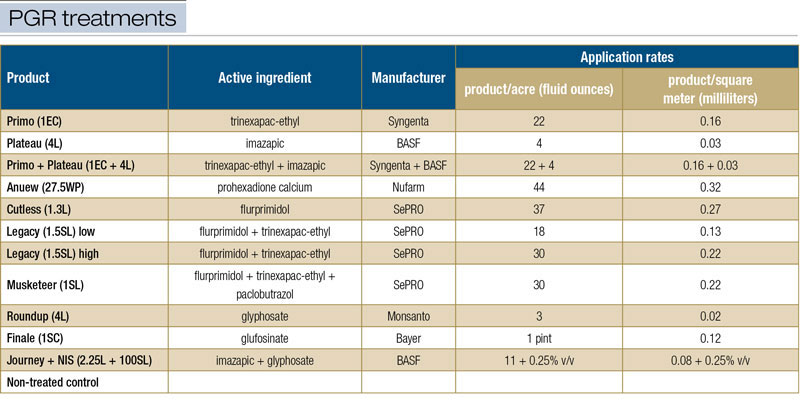
Table 1. Treatment list and rate of product used in a plant growth regulator study on bermudagrass roughs.
Treatments were applied at the beginning of three summer months, following mowing to 2.5 inches (6.4 cm) with clippings removed. After 30 days, data was collected, and all plots were mowed back to 2.5 inches. Turf phytotoxicity data was collected weekly, after treatment application, and rated on a scale of 0% to 100%, where 0% is no phytotoxicity, 100% is complete death of the turfgrass, and 30% is considered the maximum acceptable level. Turf height and seedhead cover data were both collected at the end of the monthly application cycle. Seedhead cover was rated on a scale of 0% to 100%, where 0% is no seedheads and 100% is complete seedhead coverage.
Results
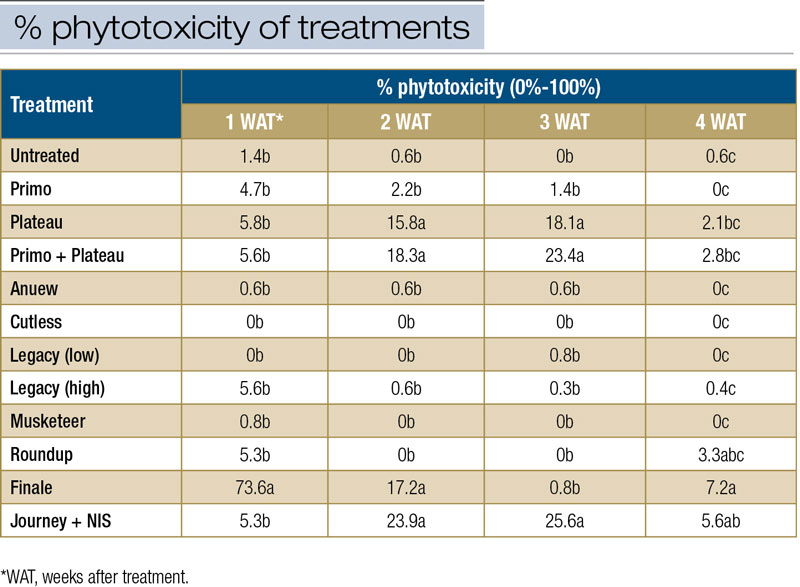
Table 2. Average percent phytotoxicity of various products over the course of the study exploring various PGR use on golf course roughs. Ratings above 30% were considered unacceptable. Different letters within a column indicate statistical differences.
Phytotoxicity
Phytotoxicity findings are listed in Table 2. Relatively rapid phytotoxicity was evident in plots treated with Finale (Figure 1), and in some instances, damage was obvious the day following application. No other treatments caused any phytotoxicity at this point in the study. Phytotoxicity in Finale plots was transient and was greatly reduced one week after application, and was basically unnoticeable by three weeks after application. Compared with other plots, those treated with Finale also exhibited enhanced turf greening after phytotoxicity subsided. Greening likely results from the nitrogen supplied to the turf by the ammonium (amine) in Finale, which could promote a flush of color and growth after application.
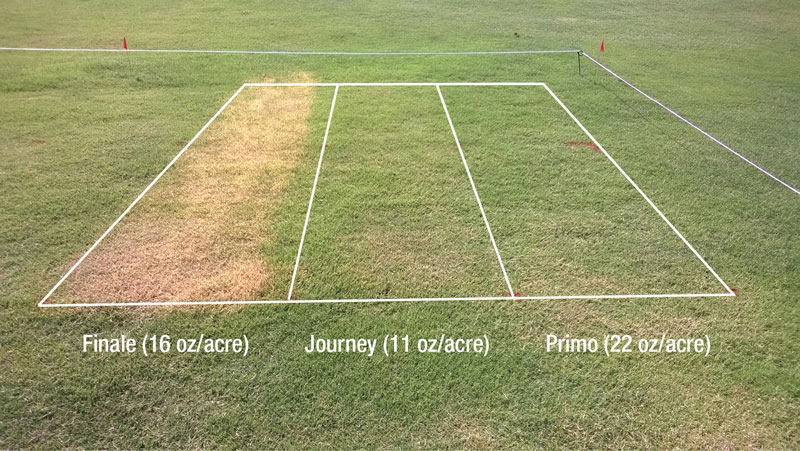
Figure 1. Distinct phytotoxicity symptoms are seen in bermudagrass rough one week after initial application of Finale at 16 ounces/acre; plots treated with Journey and Primo do not show phytotoxicity. Photos by Philip Brown
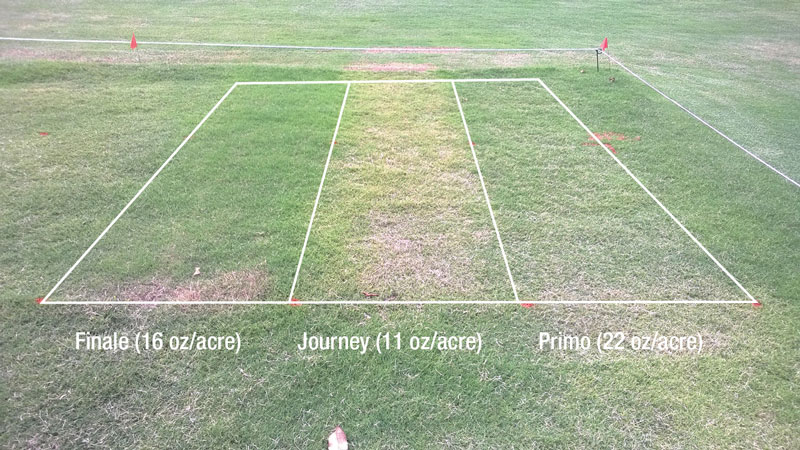
Figure 2. Three weeks after initial application, bermudagrass rough plots treated with Journey (imazapic) show phytotoxicity, whereas plots treated with Finale and Primo do not. The Finale plot had recovered from initial phytotoxicity (see Figure 1).
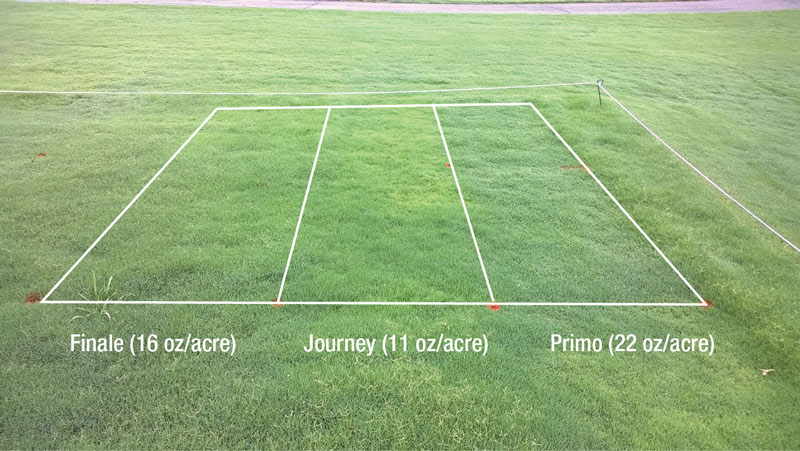
Figure 3. Four weeks after initial application of Finale, Journey and Primo, all the treated plots in the bermudagrass rough had recovered from phytotoxicity. The Primo plot has visibly lower turf height and darker green color.
The active ingredient imazapic was a component of three treatments (Plateau, Plateau + Primo, and Journey), and it also caused phytotoxicity, but at different times than Finale. By two weeks after the initial application, application of products containing imazapic had resulted in about 20% phytotoxicity, which increased to approximately 25% at three weeks after initial application (Figure 2). Damage was still visible at four weeks after application, and all phytotoxicity ratings on all dates were within the maximum damage threshold (30%). Imazapic is an acetolactate synthase (ALS) inhibitor herbicide, and therefore some degree of plant damage can be expected.
Several other treatments caused minor levels of phytotoxicity, but this was not consistent between replications and was usually short-lived and within acceptable levels. By the end of each monthly study cycle, all plots had fully recovered from phytotoxicity damage (Figure 3).
Turf height
Plots treated with Roundup and Finale showed only minor differences in turf height compared with the untreated plots (Figure 4). In the case of Finale, its ammonium content likely causes a flush of growth. The simultaneous lack of phytotoxicity and reduced growth in the Roundup-treated plots suggest that a higher concentration of the herbicide may be required to achieve the desired results. This should be investigated with future research.
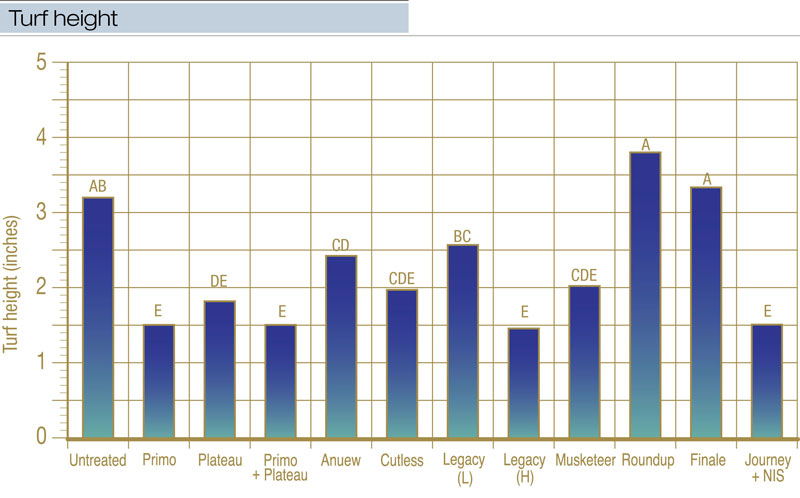
Figure 4. Bermudagrass turf height (inches) of plots treated with various PGR and herbicide products four weeks after initial application. Bars designated with different letters are statistically different.
Plots treated with products containing imazapic had low turf height, but this could be attributed to the phytotoxicity damage caused by the product. Therefore, the benefits of low turf height should be weighed against the drawbacks of visible damage.
The turf heights of Primo-treated plots were consistently among the lowest in the study, with little to no observable phytotoxicity. Primo-treated plots also suffered very little scalping after mowing compared with several other treatments.
The low rate of Legacy, 18 fluid ounces/acre (1.31 liters/hectare), produced turf height that was statistically similar to that of the untreated plots. Increasing the rate of Legacy to 30 fluid ounces/acre (2.19 liters/hectare) resulted in excellent turf height control.
Seedhead cover
All treated turf had fewer seedheads than the untreated turf (Figure 5). Roundup provided the least seedhead control, indicating again that further experimentation with rates may be justified. Plots treated with Finale or with products containing imazapic had good seedhead control (< 5% seedhead cover); however, this result must be weighed against the visible damage following these products. Primo and the high rate of Legacy provided excellent control of seedheads, and neither product caused unacceptable phytotoxicity damage during the study.
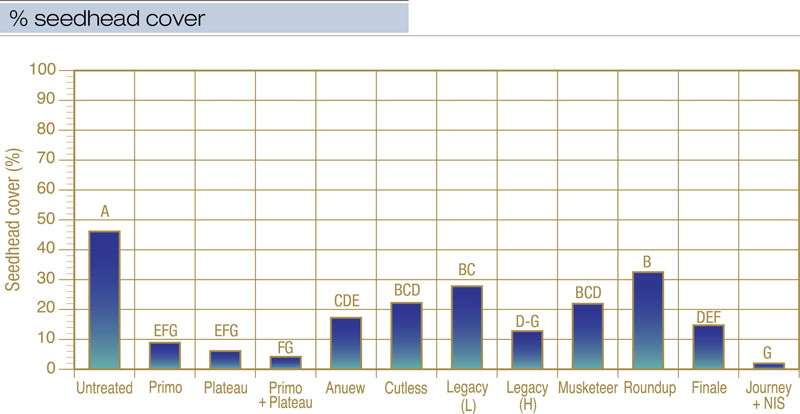
Figure 5. Bermudagrass seedhead cover (%) of plots treated with various PGR and herbicide products four weeks after initial application. Bars designated with different letters are statistically different.
Additional interesting observations were noted during the seedhead portion of the study. Seedhead cover was different at different dates, with early rating dates having higher cover than later dates. Repeated applications of PGRs likely contributed to this difference. Seedhead control was also evident in plots treated with Finale several weeks after the study concluded compared with the plots around them. This seedhead control could have been caused by the earlier phytotoxic damage, which may have slowed the development of seedheads.
Conclusions
The results of this study indicate that using PGRs and lighter rates of herbicides could reduce mowing in roughs — and, potentially, labor costs. Several treatments may be unsuitable in certain situations because they cause phytotoxicity. However, damage from phytotoxicity was usually at relatively low levels or short-lived. All treatments showed an advantage over the untreated plots in terms of seedhead suppression, but the height of turf treated with Roundup and Finale was not significantly reduced when compared with the untreated turf. During the course of the study, visible differences could be seen clearly in some of the plots, as Primo and Finale plots were regularly darker than adjacent plots.
Additional research should explore higher rates of certain products such as Roundup, tank-mixing products, or reducing turf phytotoxicity by adding low rates of nitrogen, iron or, possibly, a biostimulant. An additional cost-saving step could possibly involve boomless (flood-type) sprayers, assuming treatment coverage remains acceptable. These sprayers would eliminate the need for a rigid boom and allow faster application.
The research says ...
- We tested 11 PGR and herbicide treatments on bermudagrass roughs to determine whether their use could effectively reduce turf height and seedhead cover.
- Finale caused more severe damage initially, but the turf recovered quickly. Products containing imazapic caused delayed damage that lasted longer.
- Treatments with Primo and the high rate of Legacy produced the lowest turf height.
- PGRs and low rates of herbicides show potential for reducing mowing frequency in roughs. Additional research would help identify means of reducing turf phytotoxicity.
Literature cited
- Crownover, M. 2010. How many acres are needed for an 18-hole golf course? Golfweek (http://golftips.golfweek.com/many-acres-needed-18-hole-golf-course-1812.html) Accessed Dec. 4, 2017.
- McCarty, L.B. 2011. Best golf course management practices. 3rd edition. Prentice Hall, Upper Saddle River, N.J.
- Ross, M., and D. Childs. 1996. Herbicide mode-of-action summary. Purdue University Cooperative Extension Service, Publication WS-023-W (www.extension.purdue.edu/extmedia/WS/WS-23-W.pdf) Accessed Nov. 28, 2017.
- Sherratt, P. 2013. All about plant growth regulators. SportsField Management. Accessed Nov. 28, 2017.
- Totten, F.W., J.E. Toler and L.B. McCarty. 2006. ‘Tifway’ bermudagrass growth regulation with the use of trinexapac-ethyl and flurprimidol. Weed Technology 20(3):702-705.
Philip Brown is a graduate student; Don Garrett, CGCS, is superintendent of the Walker Course; and Bert McCarty is professor of turfgrass science and management at Clemson University, Clemson, S.C.